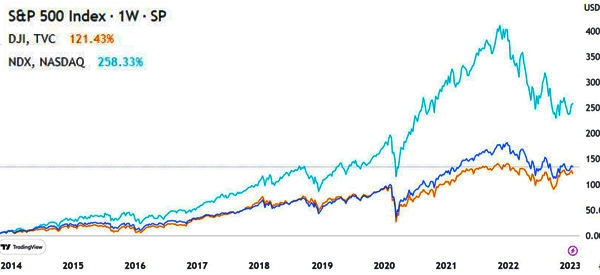[ad_1]
Indexes or indices are important assets in the financial industry. They are financial instruments that track a group of stocks in one or more industries.
For example, the Nasdaq 100 index tracks the biggest technology companies in the US while the S&P 500 follows the largest publicly-traded companies in the country.
In this article, we will look at what the S&P 500, Dow Jones, and Nasdaq 100 indices are and how to trade and invest in them.
What is the S&P 500 index?
The S&P 500 is the most important index in the United States. It is also the most popular. It tracks the 500 biggest companies in the US. As such, using the index can provide more information about the state of the American stock market.
Therefore, when you hear market commentators say that American stocks rose or fell in a certain period, they are mostly focusing on the S&P 500 index.
The S&P 500 index was started in 1957 and has seen spectacular returns over the years. It is estimated that the index has surged by more than 4,000% since its founding. This means that a dollar invested in the index has grown to over $400 in that period.
The biggest constituent of the S&P 500 index is Apple, which has a market cap of over $2.1 trillion. It is followed by Microsoft, Alphabet, and Amazon. Other large S&P 500 companies are Tesla, Berkshire Hathaway, ExxonMobil, and JP Morgan among others.
What is the Dow Jones?
The Dow Jones is one of the oldest indices in the financial industry. Started in 1896, the index tracks 30 companies that have a good representation of the American economy.
Therefore, while the index is made up of giant companies, several others like Berkshire Hathaway and Alphabet are not members.
Instead, the index has some companies like Walgreens Boots Alliance, Dow Inc., Travelers, and 3M that are not among the top 50 of the biggest companies in the US. The biggest Dow Jones constituents are Apple, Microsoft, Visa, UnitedHealth, J&J, and Walmart.
What is the Nasdaq 100?
The Nasdaq 100 index is another popular index that focuses on the technology sector. It was started in 1986 and now has companies valued at more than $15 trillion. This makes it one of the biggest indices in the financial industry.
Unlike the Dow Jones, the Nasdaq 100 tends to have many growth companies that are not profitable. In the era of low interest rates, the Nasdaq 100 index vastly outperformed the S&P 500 and Dow Jones. This trend ended in 2022 as the Federal Reserve embraced one of the most hawkish tones.

How to invest and trade indices
Ideally, based on how they are structured, it is not possible to invest in indices directly. That’s because indices are usually created by index providers like S&P Dow Jones, Bloomberg, FTSE, MSCI, MorningStar, and Solactive. These indexes make money by licensing their indices to other financial services companies.
There are two main ways of investing in indexes like the Dow Jones, Nasdaq 100, and S&P 500. First, you can invest in index CFDs, which are products that simply track the performance of these indices.
Second, you can invest in ETFs that track these indexes. An ETF is a financial product that tracks an index and charges you a small expense ratio. The biggest indices are created by companies like Blackrock, Vanguard, Schwab, State Street, and T.Rowe Price among others. There are now over 8,500 ETFs globally.
The most popular Nasdaq 100 ETF is Invesco QQQ. Other popular ETFs are the SPDR S&P 500 ETF and Vanguard Dow Jones ETF.
The benefit of using ETFs in trading indices is that you can use any broker, including Robinhood, Schwab, and TD Ameritrade to do it.
Types of indices or indexes
The Dow Jones, Nasdaq 100, and S&P 500 indices are the most popular indices in the United States. There are many other indices that you can focus on. Some of these are:
Sector indices – These are indices that focus on the 12 sectors of companies in the US. They include transport, industrial, finance, technology, and consumer among others.Market cap indices – These are indices that focus on company market cap. A good example of these indices is the FTSE 100, which looks at the 100 biggest firms in the UK.Discretionary indices – These are indices that are created to track different types of companies to provide investors with various exposures. For example, the Bloomberg clean energy index looks at companies in the clean energy industry.
Index trading strategies
There are several index trading strategies. The most popular ones are:
Trend following – This is a strategy that involves buying an index when its price is rising and shorting it when the price is falling. Traders use several approaches to use this strategy, including using trend indicators like moving averages and Bollinger Bands.Reversal trading – This is a trading approach that includes trading reversals. It is a popular approach among traders. One way of trading reversals is using trend indicators like moving averages and identifying their crossovers.Scalping – This is a trading strategy that involves buying and selling an index within a short period of time. The goal is to open several trades per hour and exit with a profit.Arbitrage – This is an index trading strategy that involves buying and shorting two indices at the same time. For example, you can buy the Dow Jones and short the Nasdaq 100 index since the two tend to move in the same direction.Swing trading – This is an approach that involves buying or shorting an index and holding the trade for a few days.
Summary
In this article, we have looked at the most popular indices in the world like Dow Jones, Nasdaq 100, and S&P 500 indices. Also, we looked at when they were formed, how they differ, and some of the top strategies to trade them.
External useful resources
What are the differences among NYSE, Dow Jones, NASDAQ and S&P 500? – Quora
[ad_2]










